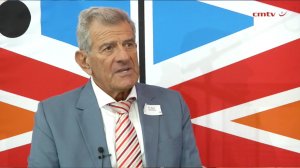Although Finance Minister Enoch Godongwana’s Budget, delivered on February 21, seemed somewhat prudent, Econometrix director and chief economist Dr Azar Jammine said there was not much in it to make one optimistic about South Africa’s economic future either.
“The Budget does provide some relief for markets in the sense that it was not reckless. It maintained an element of fiscal austerity. I wasn't disappointed with the budget but I wasn't particularly excited either. There was nothing in it that tells me that economic growth is going to pick up from 1.3% a year to more like 3% to 5% a year to start creating more jobs,” he said.
Speaking at an event hosted by cement company AfriSam in Modderfontein, Gauteng, on February 23, he pointed out that the heart of South Africa’s economic failure or success depended on its levels of fixed capital formation.
“Theoretically, more money is to be spent on infrastructure. That is, on paper, a very positive development. But will we actually see that materialising? Unfortunately, looking through it all, I still got the sense of: what is it in this Budget that’s going to spark economic growth to rise more strongly? I didn’t get that sense,” he said.
Jammine pointed out that South Africa’s fixed capital formation has recovered somewhat to 15% of gross domestic product (GDP), signalling signs of hope.
However, he explained that, on average, in emerging countries such as South Africa, capital project investment should account for between 25% and 30% percent of GDP.
Jammine noted that fixed capital formation had declined from a peak of 24% of GDP just before the World Cup in 2008, to about 19% of GDP in 2013 and 2014, followed by a significant decline to below 13% of GDP in 2021.
He said the needle was once again moving in the right direction, but the persistence of corruption and crime would threaten to undermine progress.
Jammine pointed out that, over the past decade, as fixed capital formation declined, consumer spending conversely increased – a trend that he said was unsustainable.
“Since 2020, the trend of capital investment has started moving in an upward direction far more expeditiously than consumer spending. So structurally, we are starting to see some things coming right. The bad news was that in the third quarter of last year, we saw a bit of a dip in that and one hopes that that was just a temporary phenomenon,” he said.
However, in determining where current capital formation was coming from primarily, Jammine noted that the private sector had been persistently outpacing government. State-owned entities (SOEs) have performed particularly poorly.
“They've run out of money to do much investing,” he said.
In the construction sector, Jammine pointed out, the lion’s share of investment had gone into machinery and equipment instead of new developments.
“Africa has not lagged totally behind from a technological perspective, investment in machinery and equipment has recovered quite nicely in recent years. But the bad news is that the construction sector, which incorporates civil engineering, residential and non-residential building activity, has seen about a 40% to 45% decline over the last decade. It is horrific, and there is little sign of a recovery,” Jammine said.
He said it was good news that the share of capital expenditure to the total budget was set to rise from 4.7% to 5.9% over the next three years, meaning that government intended to raise its own capital spending by 10% a year.
“But we have faced that already in the past and we're still waiting to see the manifestation of increased government spending on capital projects, and they haven't materialised. So can we believe these numbers going forward?” he mused.
He noted the R943.8-billion that Godongwana promised to spend on energy, water and sanitation, transport and logistics. He said this figure was about 12% higher than the R812-billion projected a year ago.
“If that's any consolation, there is more money that's been put officially into the pipeline for capital projects over the next three years,” Jammine said.
He said. however, the Budget was essentiall built around several short-term, one-off fixes that were not sustainable in the long term, and that addressing several key issues was the only way to ensure faster economic growth.
In Jammine’s view, the biggest issues, pointed too, could be summarised as corruption and cadre deployment feeding through to poor management and incompetence at South African SOEs.
“Then of course, integral to that is energy insecurity, transport bottlenecks, low investment relative to consumption, over-regulation and bureaucracy, government wanting to do everything itself rather than embrace the private sector, and cadre deployment leading to a lack of capacity - especially at municipal level - to implement,” Jammine said, adding that at the heart of it all, South Africa needed to create human capital skills that can actually cope with a more technologically intensive economy that requires those skills to take full advantage of the opportunities that are there.
“It's not a total disaster. It could be worse. It's not collapsing,” he concluded.





